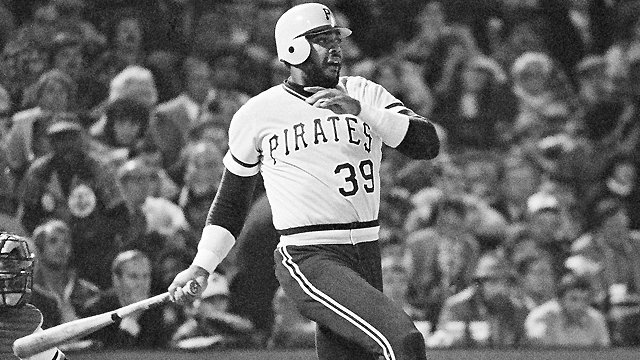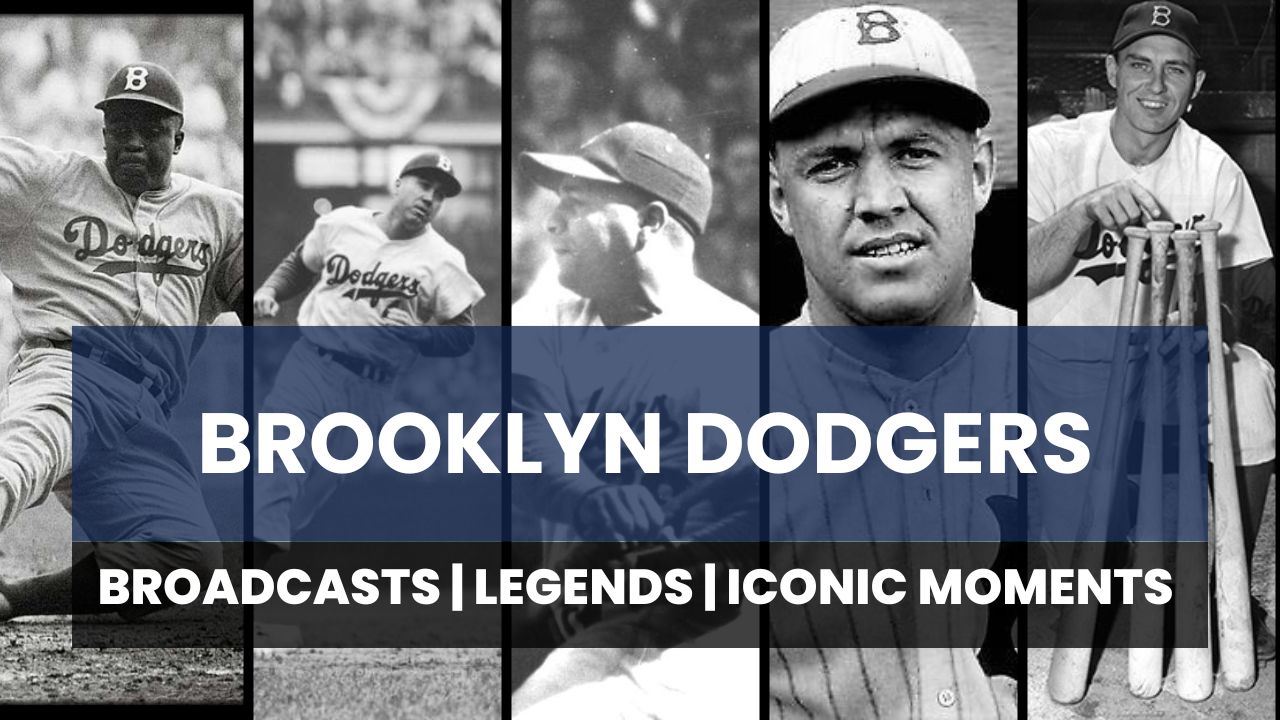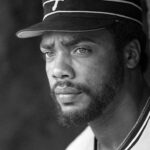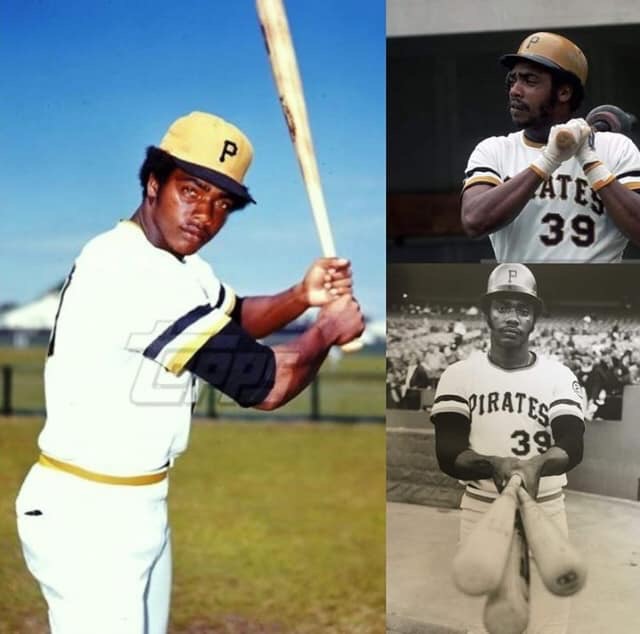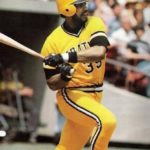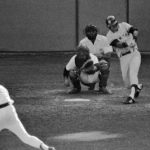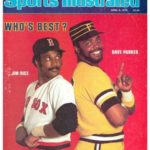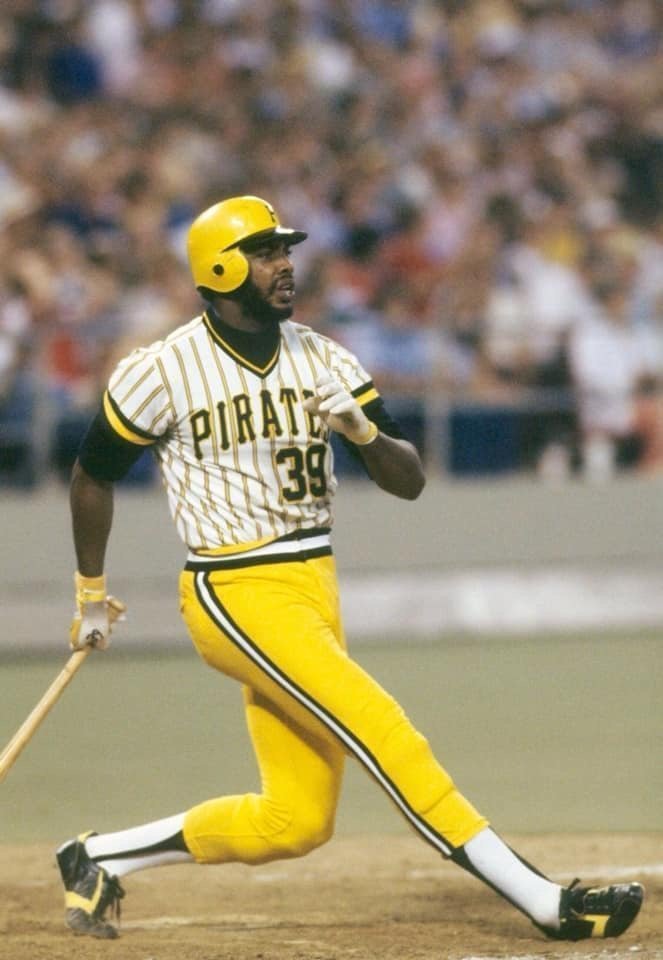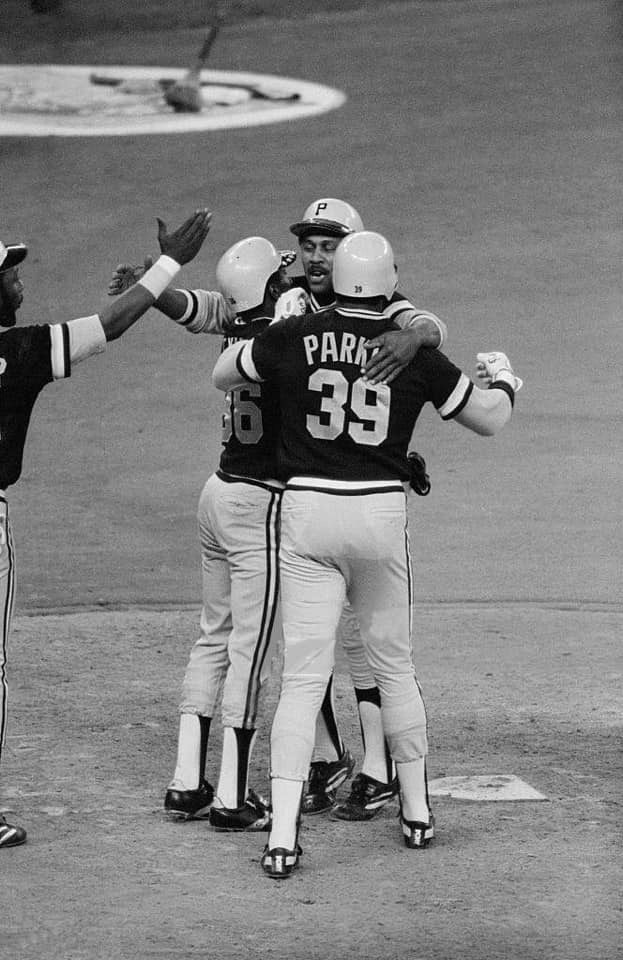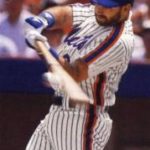Dave Parker Stats & Facts
Dave Parker
Position: Rightfielder
Bats: Left • Throws: Right
6-5, 230lb (196cm, 104kg)
Born: June 9, 1951 in Grenada, MS
Draft: Drafted by the Pittsburgh Pirates in the 14th round of the 1970 MLB June Amateur Draft from Courter Tech HS (Cincinnati, OH).
High School: Courter Tech HS (Cincinnati, OH)
Debut: July 12, 1973 (Age 22-033d, 10,995th in MLB history)
vs. SDP 4 AB, 0 H, 0 HR, 0 RBI, 0 SB
Last Game: October 2, 1991 (Age 40-115d)
vs. CAL 2 AB, 1 H, 0 HR, 0 RBI, 0 SB
Full Name: David Gene Parker
Nicknames: Cobra
View Player Bio from the SABR BioProject
Nine Players Who Debuted in 1973
Dave Winfield
George Brett
Dave Parker
Brian Downing
Frank White
Bill Madlock
Frank Tanana
Steve Rogers
Randy Jones
Notable Events and Chronology for Dave Parker Career
The Pirates have had three players during their long history who for a period of time were considered the best all around players in the game. The first was Honus Wagner, universally praised as the greatest player of the first decade of the 20th century. More recently, Barry Bonds dominated baseball as its best player while in Pittsburgh during the early 1990’s and reached greater heights after leaving the Steel City. The third…well, Clemente and Stargell were truly great players during their careers, but Clemente played during the era of Mays and Aaron and had his two greatest seasons in 1966 and 1967, years when Frank Robinson and Carl Yastrzemski won the American League Triple Crown. Stargell, baseball’s top power hitter during the early 1970’s and blessed with a great arm, did not have impressive speed. As excellent a batsman as Paul Waner was his best years were overshadowed by that big guy in pinstripes and later by fellow Yankee, Lou Gehrig. Arky Vaughan might have held the title, but if so, only during 1935 and the baseball writers did not see fit to name him the National League’s MVP. Pie Traynor, incredible at third and a consistent hitter, led the NL in only one offensive category during his whole career. No, the third man in this franchise’s thrilling history is David Eugene Parker, a powerfully built giant who was accepted as baseball’s complete player in the late 1970’s.
Parker was nicknamed “The Cobra” by Bob Prince who observed the lefthanded hitter was always poised to strike at the plate. Although praised as a “can’t miss” prospect by 1972, Parker had been passed over in the amateur draft until the 14th round. The reasons for this were that he had injured his knee playing high school football and he had gained a reputation as a fighter in high school and these factors scared off several scouts when Parker became eligible for the draft in 1970, including those in his hometown of Cincinnati. Parker quickly proved he could play by hitting .314 at Bradenton and was named the Gulf Coast League MVP.
Jumped to AA in 1971, Parker was overmatched and the Pirates wisely moved him back to Class A Monroe where he hit .358 with 11 homers, 48 rbi’s and 18 stolen bases in 71 games. Moved to Salem in the Carolina League, a tougher A ball league, in 1972, Parker dominated by leading the circuit in batting (.310), AB’s (523), runs (91), hits (162), doubles (30), rbi’s (101) and stolen bases (38 in 45 attempts). He also smashed 22 homeruns. Joe L. Brown called him one of the five best prospects he had seen in his many years with the organization. The Pirates, well stocked with outfielders, could afford not to rush the 6’5” 225lb batting behemoth. Parker, though, thought he was ready and had a verbal altercation with Minor League Director Harding Peterson the following spring. He did not make the major league squad, but was promoted to AAA Charleston. His development continued, batting .317 with nine homers and 57 rbi’s in 84 games before he was recalled to replace the injured Gene Clines on the Pirates roster. His play, rough at times, impressed enough for the Pirates to release Vic Davalillo, who had batted .318 the year before, and keep Parker when Clines returned. During a tight September pennant race, Parker hit .354 and finished his rookie season only two hits short of batting .300 in his 139 times at bat. The Cobra was especially venomous against division rival St. Louis, batting .520 (13 for 25) against them and his play against the Cardinals probably stopped them from finishing ahead of the Mets.
The Pirates still had baseball’s best outfield with Stargell, Al Oliver and Richie Zisk, so it appeared Parker would be a backup in 1974. Manager Danny Murtaugh tried a gutsy experiment by platooning the youngster with Bob Robertson at firstbase early that season. The move was abandoned, however, as Parker, although not being charged with an error, did not adjust well to the position which caused problems for the other infielders and the team got off to a dreadful start. Parker suffered through ’74 with hamstring injuries which twice put him on the disabled list and while he hit a respectable .282, his power numbers were disappointing.
Murtaugh, though, realized he had to get Parker into the lineup in 1975 and late in spring training the manager benched Robertson, moved Stargell to first and Zisk to left to open up rightfield for Parker, who’s arm could best be taken advantage of in Clemente’s old position. The Cobra struck. He led the NL in slugging (.541) and batted .308 with 25 homeruns, 38 doubles, ten triples and 101 rbi’s, becoming the deadliest batter in the Pirates’ Eastern Division winning lineup which soon became known as “The Lumber Company.” He also contributed 10 game winning hits and had a six rbi game on May 9. His arm, becoming more accurate, held opposing baserunners at bay and his skills as an outfielder, particularly his judgement of fly balls showed improvement. While stifled by Reds pitching, going 0-for-10, in the playoffs, Parker’s regular season performance earned him a spot on The Sporting News’ National League All-Star Team.
Parker again suffered from hamstring problems in 1976, but raised his average to .313, eighth in the league and led the team with 90 RBI. Parker quickly joined in Murtaugh’s new running game with 19 stolen bases and tied Zisk and Rennie Stennett for the team lead with 168 hits.
Chuck Tanner took over the Pirates in 1977 and his outgoing enthusiasm and support, if not outright helping Parker, coincided with the rightfielder’s play moving up another notch. Still only 25 when the season began, Tanner moved Parker to the number 3 spot in the batting order (he had hit fifth or sixth under Murtaugh depending on the opposition’s pitcher) and Parker put together a 22-game hitting streak which raised his average well over .400 early in the year, and projected the Pirates into first place into late May. While the Phillies eventually caught and passed the Pirates, Parker had a great season. Named to the All-Star team, he took a .330 average with 14 homeruns and 64 rbi’s with him to Yankee Stadium. He also had another 22-game streak during the year, which began shortly before the All-Star Game and ended on August 11. Parker finished the season with his first batting title (.338) and also led the NL in hits (215) and doubles (44). He scored 107 runs and drove in 88 and finished second to the Reds’ George Foster with 338 total bases. His batting title was the first by a Pirates since Clemente in ’66 and hew as the first Pirate to collect 200 hits since Matty Alou seven years earlier. He easily outdistanced all outfielder’s with an incredible 26 assists. The next highest total was Dave Winfield’s 15. Tanner called him “the best big man” he had ever seen in baseball as far as being a complete player. HOF writer Charlie Feeney predicted “within two years (Parker) would be ranked the Number One star in the Game.” Parker didn’t wait that long.
With the Bucs playing less than .500 ball going into the All-Star break, the Cobra, along with the resurgent Stargell, was doing his best to keep the team from falling completely out of the race. He not only was putting up the numbers (13-47-.316), as his hustle and determination were inspiring especially considering the team’s disappointing play. Acknowledged as one of baseball’s most hustling and dangerous players on the bases (he had fractured Phil’s catcher Johnny Oates’ collarbone in a home plate collision to win the season opener in ’76 and had also barreled over the seemingly immovable Steve Yeager of the Dodgers), Parker himself suffered a broken cheek bone when he tried to run over the Mets’ John Stearns on June 30. Surgery was required, but Parker missed only 11 games, emerging from the Pirate dugout wearing a special helmet, equipped with a special facemask to protect his injured cheek when he returned after having to sit out the All-Star Game. Although some, including the Dodgers’ Tommy Lasorda objected to Parker’s new equipment when he was running the bases, he was given permission to continue doing so.
Far from gun-shy, Parker’s play got even better the second half. He batted .381 in August and .415 in September to become the first player to win the National League’s Player of the Month Award in back to back months. Parker’s surge led the Pirates to a 37-12 record down the stretch and gave the team a chance for a miracle Eastern Division Title until the second to last game of the season. Named the National League’s Most Valuable Player, Parker finished with his second batting a and slugging titles at .334 and .585, respectively. He established a new career high with his 117 RBI, good for second in the league, only three less than Foster. His 30 homeruns were the most ever by a Pirate right fielder, breaking Clemente’s record of 29 set in his MVP year of 1966. Parker also became the first 20/20 player in franchise history. While opposing base runners tested Parker far less often, he won his second gold glove. Free agency was still in its infancy, but as soon as the 1978 season ended, many questioned whether the small market Pirates would be able to afford to keep the best player in baseball. The Galbreath family realized it was imperative they did and anteed up the richest contract in baseball history to date, signing Parker to a $7 million deal over the next five seasons.
Parker’s personality was as loud as his bat, but he seemed to get along well with teammates. He recognized his status in the game and loudly proclaimed in spring training, 1979, “When the leaves turn brown, Dave Parker will have the batting crown.” After signing his contract, he stated he planned to show the public a player who got big money could still play aggressively. However, there were some problems, which began to effect the public’s opinion of him, such as neglecting commitments with media personnel and questions about his personal life.
Parker had a streaky year in 1979. He was especially hot in late June when he hit over .486 in 13 games and the final week of the season when his average bettered .500. Parker was again elected to the All-Star Game and although his midseason average was down to .297, he was among the league leaders with 16 homeruns and 54 rbi’s. The opposition was pitching around him even more and a free swinger by nature, Parker sometimes found it hard to lay off borderline pitches. Still his bases on balls increased.
1978’s NL MVP became 1979’s All-Star Game MVP when Parker made two eye-popping throws to nail Jim Rice trying to stretch his hit into a triple and to throw out Brain Downing trying to score the tie breaking run later in the game.
Parker didn’t win the batting crown in ’79, but he hit .365 for September to tow the Pirate ship into the postseason. In what most considered a down year, Parker led the league in extra base hits and sacrifice flies and finished second in total bases and runs and was in the top ten in doubles (third), hits (sixth), slugging and batting (seventh) and rbi’s (eighth). He was the top man in rbi’s, doubles and walks for The Family and second in runs, hits and homeruns. Parker also won his third strait gold glove and again was a member of the 20-20 club.
In the playoffs, Parker drove in the winning runs in both Games 2 and 3, batting .333 in the Pirates sweep of the Reds. Undoubtedly, some fans from his hometown must have bemoaned Cincinnati not being willing to take on his injured knee or some attitude back in 1970. Against Baltimore in the World Series, he batted .345 and drove in four runs, including the one, which broke a scoreless duel between Jim Palmer and John Candelaria in Game 6.
Parker’s old knee injury resurfaced in 1980 and he played in pain most of the season. His numbers declined and although he continued to play hard on the field, Pittsburghers targeted him verbally and physically. He became the scapegoat when The Family started to have problems. During one horrid event, some idiot threw a battery at Parker from the upper deck at Three Rivers Stadium. Parker fought back verbally. The outfielder’s bravado, which had been compared to Mohammed Ali’s, had not played well in Pittsburgh, where, as Bonds would find out a decade or so later, the fans liked their heroes humble and gracious, and he alienated some who did support him by claiming racism rather than stupidity and jealousy was at the root of the harassment he received. Fans were also ignorant of the seriousness of Parker’s injury, which required surgery following the season. Some later said Parker should have had the surgery sooner, but he recognized his importance to the team and with Stargell lost to the club in August, his .295 average could not afford to come out of the lineup.
However, following surgery, Parker came to camp overweight in 1981 and the extra weight, combined with a poor season gave the appearance Parker had ceased trying to be the game’s number one player. The Pirates, finishing last the second half of the strike interrupted year, were interested in moving the high priced player, but found no serious takers.
In 1982, Parker suffered a torn cartilage in his right wrist and ruptured ligaments in his left thumb. He played in 73 games, batting .270 with just 29 RBI. Although Parker was healthier in 1983, he was no longer Tanner’s number three hitter, and batted just .279 with a dozen homers and 69 rbi’s. The Pirates made no serious efforts to retain him as his contract expired and he signed with his hometown Reds in 1984.
At the end of the 1983 season, Parker became a free agent and signed with the Cincinnati Reds. In Cincinnati, he returned to the form that made him an All-Star in Pittsburgh. In 1985, he enjoyed his best season since he won the 1978 MVP with a .312 batting average, 34 home runs, and 125 RBI. Parker finished second in 1985 MVP voting to Willie McGee.
After the 1987 season, Cincinnati traded Parker to the Oakland Athletics for José Rijo and Tim Birtsas. In Oakland, Parker was able to extend his career by spending most of his time as a designated hitter. Although injuries and age caught up to him to a degree – he hit just .257 with 12 homers in 377 at-bats in 1988 and .264 with 22 homers in 553 at-bats in 1989 – his veteran leadership was a significant factor in the A’s consecutive World Series appearances.
Parker signed with the Milwaukee Brewers for the 1990 season and had a solid year as the Brewers’ DH with a .289 average and 21 home runs in 610 at-bats. However, Milwaukee opted for youth at the end of the year and traded the aging Parker for Dante Bichette.
Parker’s last season was 1991. He played for the California Angels until late in the season when he was released. The Toronto Blue Jays then signed him as insurance for the pennant race, and Parker hit .333 in limited action. However, since he was acquired too late in the season, he did not qualify for inclusion on the post-season roster and thus was unable to play in the American League Championship Series against the Minnesota Twins, which the Blue Jays lost in five games. Parker retired at the end of the season.
Retirement
Parker has served as a first-base coach for the Anaheim Angels, a batting coach for the St. Louis Cardinals in 1998, and a special hitting instructor for Pittsburgh. He owns several Popeye’s Chicken franchises in Cincinnati. Parker now has had both of his knees replaced due to knee injuries from his playing career.
When it came to light that Parker had used cocaine during his later years with the Pirates during baseball’s drug trials in 1985. Although he had reportedly quit using the substance by the time of the trials, his reputation was tarnished and this is likely a factor in some voter’s minds as they review Parker’s candidacy for Cooperstown. Parker never got more than 24% of votes on Hall of Fame ballots and his 15-year Baseball Writers Association of America eligibility was exhausted on the 2011 ballot.
@ET-DC@eyJkeW5hbWljIjp0cnVlLCJjb250ZW50IjoicG9zdF90YWdzIiwic2V0dGluZ3MiOnsiYmVmb3JlIjoiTGVhcm4gTW9yZSBhYm91dCB0aGUgdGVhbXMsIHBsYXllcnMsIGJhbGwgcGFya3MgYW5kIGV2ZW50cyB0aGF0IGhhcHBlbmVkIG9uIHRoaXMgZGF0ZSBpbiBoaXN0b3J5IC0gLSAtIC0gLSAtIC0gIiwiYWZ0ZXIiOiIiLCJsaW5rX3RvX3Rlcm1fcGFnZSI6Im9uIiwic2VwYXJhdG9yIjoiIHwgIiwiY2F0ZWdvcnlfdHlwZSI6InBvc3RfdGFnIn19@
Best Season, 1978
NL MVP Voting Results:
Parker… 320
Steve Garvey… 194
Larry Bowa… 189
Reggie Smith… 164
Jack Clark… 107
George Foster… 104
Greg Luzinski… 48
Gaylord Perry… 45
Willie Stargell… 39
Dave Winfield… 37
Awards and Honors
1977 NL Gold Glove
1978 NL Gold Glove
1978 NL MVP
1979 ML AS MVP
1979 NL Gold Glove
Post-Season Appearances
1974 National League Championship Series
1975 National League Championship Series
1979 National League Championship Series
1979 World Series
1988 American League Championship Series
1988 World Series
1989 American League Championship Series
1989 World Series
Big League Debut: July 12, 1973
As a high school player, Parker underwent surgery on his left knee. The injury was the primary reason that he slipped to the 14th round in the 1970 June draft.
Notes
In 1975, his first season as a regular, Parker hit .259 against southpaws and .339 against RHP. He batted .272 at Three Rivers Stadium, and .359 on the road.
Injuries and Explanation for Missed Playing Time
Parker spent time on the DL in 1974 with a severe hamstring pull… In spring training in 1976, Parker set his goals for the season: “I’d like to add 10 points to my average, hit 10 more home runs and drive in 10 more runs.” But a few nagging injuries (the hamstrings again) kept him out of the lineup for a few days here and there, and he fell short, raising his batting average five points, hitting 12 fewer homers, and driving in 11 fewer runs.
Hitting Streaks
22 games (1977)
22 games (1977)
22 games (1977)
22 games (1977)
15 games (1980)
15 games (1980)
Quotes About Parker
“Parker gave 100 percent effort in every inning of every game that he played. He was one of the greatest I ever managed and one of the greatest who ever played, in my opinion. He has Hall of Fame credentials.” — Chuck Tanner
Quotes From Parker
“I think the day will come when I’ll be the Stargell in the lineup.” — Parker, in 1976
“There were a couple of years where my numbers probably weren’t what they should have been. But for the majority of those 10 years, from 1975 to ’80, I was probably the best player in the game…. I should be in the Hall of Fame. Ain’t no doubt about it.” — reflecting on his career, 2006
All-Star Selections
1977 NL
1979 NL
1980 NL
1981 NL
1985 NL
1986 NL
1990 AL
Other Resources & Links

